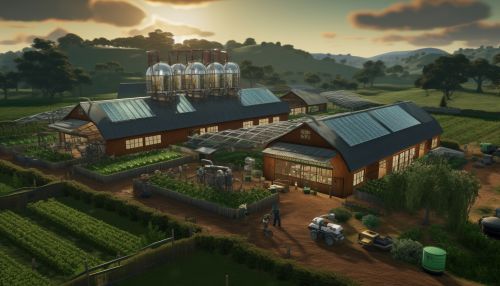Smart Farming
Overview
Smart farming, also known as Precision Agriculture, is an approach to farm management that uses information and communication technology (ICT) to ensure optimum health and productivity of crops and livestock. It involves the integration of advanced technologies into existing farming practices in order to increase production efficiency and the quality of agricultural products.


History
The concept of smart farming emerged in the early 1980s with the introduction of GPS technology. This allowed farmers to accurately map their fields, apply inputs more precisely, and yield significant cost savings. The term "precision agriculture" was coined around this time to describe this new approach to farming.
Technologies in Smart Farming
Smart farming technologies are numerous and diverse, ranging from GPS technologies to advanced sensors and software.
GPS Technology
GPS technology is fundamental to smart farming. It allows farmers to accurately navigate their fields, apply inputs precisely, and monitor crop health from a distance.
Sensors
Sensors are another crucial component of smart farming. They can monitor a wide range of conditions, from soil moisture and nutrient levels to crop health and weather conditions.
Drones
Drones, also known as unmanned aerial vehicles (UAVs), are increasingly used in smart farming. They can monitor crop and livestock conditions from the air, apply inputs precisely, and even assist in harvesting.
Software
Software plays a critical role in smart farming. It allows farmers to analyze data collected from sensors, drones, and other sources, and make informed decisions about their farming operations.
Benefits of Smart Farming
Smart farming offers numerous benefits. It can increase production efficiency, improve the quality of agricultural products, reduce environmental impact, and enhance animal welfare.
Increased Production Efficiency
Smart farming can significantly increase production efficiency. By using advanced technologies, farmers can precisely apply inputs, monitor crop and livestock health, and make informed decisions about their farming operations. This can result in higher yields and lower costs.
Improved Quality of Agricultural Products
Smart farming can also improve the quality of agricultural products. By monitoring crop and livestock health and applying inputs precisely, farmers can ensure that their products are of the highest quality.
Reduced Environmental Impact
Smart farming can reduce the environmental impact of farming. By using advanced technologies, farmers can precisely apply inputs, reducing the risk of over-application and environmental contamination.
Enhanced Animal Welfare
Smart farming can enhance animal welfare. By using sensors and other technologies, farmers can monitor animal health and welfare, and take action to ensure that their livestock are healthy and comfortable.
Challenges and Future Directions
Despite its many benefits, smart farming also presents some challenges. These include the high cost of technologies, the need for technical skills, and concerns about data privacy. However, ongoing research and development are expected to address these challenges and further advance the field of smart farming.
